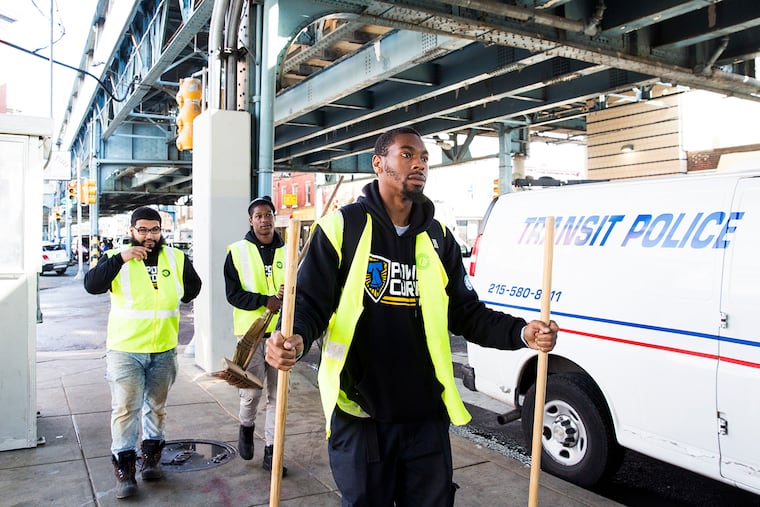Working to end public injection can bring Kensington together | Opinion
The effort to end public injection is a fight for the humanity of homeless people in addiction and the children who walk by them on the way to school.

Stories about the drug crisis in Kensington often focus on the friction between two groups: 'the community' vs. the people in addiction.
It's not uncommon for neighbors to ask "what about us?" when politicians talk about services for people in addiction in the area. Kensington is one of the poorest neighborhoods in Philadelphia, and residents often feel that resources that could have gone toward schools, parks, and libraries go toward helping homeless people instead.
Maria D. Quiñones-Sánchez, who represents Kensington, echoed this sentiment recently, saying, "Kensington has been sympathetic. Kensington residents have been patient. Pero no mas [But no more]." The statement implies that the homeless people in addiction who live in Kensington are not, in fact, "Kensington."
Addiction is not confined to the people living in encampments under bridges or in homeless shelters. The needs of both Kensington residents and the homeless people in addiction are not necessarily different.
A prime example is the effort against public injection and discarded syringes.
The Inquirer's Aubrey Whelan recently reported about the impact of public injection on school-aged children in Kensington. For the students of Lewis Elkin Elementary, just a few blocks away from McPherson Park, seeing people inject on the way to school is the new normal. Kids call it "needle park."
The people who inject drugs are not oblivious to this problem. Researchers interviewed people who inject drugs in Philadelphia about their injecting habits, and many expressed concern that kids will see them use. To avoid public injections, people engage in risky behaviors, such as injecting alone in abandoned buildings where they are more likely to be attacked and less likely to be revived with naloxone if they overdose.
It's better for everyone if those in addiction use drugs in a community, like an encampment. For those in addiction, there's a better chance that unused — and thus safer — syringes will be available and that someone nearby might have overdose-reversing naloxone. Kensington neighbors can take comfort in fewer overdoses. Additionally, it's not uncommon for some in the encampments to collect and dispose of used syringes, making the streets safer for everyone.
Of course, encampments are not an ideal solution — people still live on the street and public injection persists.
From a policy perspective, there are measures that reduce public injection and help both the children of Kensington and the people in addiction who live on the streets.
An example of this is stable housing for drug users. The researchers who interviewed people who inject drugs found that people who inject almost exclusively do so at home — when they have one. Investing in stable housing, not a shelter that is open only during the night, for people in addiction would reduce public injection dramatically.
Another example, which drew concern from some residents, is opening an overdose prevention site (commonly known as a safe-injection site) in which people can bring their own drugs and use them with supervision and safely dispose of used syringes and needles. That is both safer for people in addiction and addresses the problem of public injection. Studies from both Vancouver and Sydney found that the amount of public injection and discarded syringes dropped in neighborhoods that opened overdose prevention sites.
Kensington should have an overdose prevention site and more housing units available for people in addiction, but that will take time. There are, however, things that can be done today.
As a part of the mayor's declaration that the opioid crisis is a disaster in Kensington, the city launched a large-scale cleanup in the area. That is a great way not only to clean up the neighborhood but also a way to tear down the walls between all the people who currently live in Kensington by providing everyone a mutual goal. Why not have cleanups on a regular basis?
>> READ MORE: How a traumatized America finds relief in hate | Opinion
The children who walk by "needle park" also deserve attention.
Gabor Mate, a physician and expert on childhood trauma, told the Inquirer, "a kid who sees somebody injecting is not necessarily traumatized, not if they can go on to talk about it with their parents who understand their feelings."
Childhood trauma can have long life implications on health and mental well-being. "Children get traumatized because they have no way of processing what happened to them," Mate says. "If the same event happens to two children but one of them is held by an adult afterward and has a chance to move through their emotions, and experience their emotions, and not have to suppress them, they are not alone with it, they won't necessarily be traumatized by it."
The effort to end public injection is a fight for the humanity of both homeless people in addiction and the children who walk by them on the way to school. By providing a safe space to inject and dispose of syringes, as well as education on trauma-prevention strategies for parents and teachers, the community of Kensington as a whole can heal together.